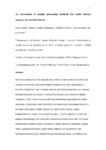An assessment of sample processing methods for stable isotope analyses of coastal foodwebs

View/
Use this link to cite
http://hdl.handle.net/2183/137Collections
- Investigación (FCIE) [1260]
Metadata
Show full item recordTitle
An assessment of sample processing methods for stable isotope analyses of coastal foodwebsAuthor(s)
Date
2004Abstract
[Abstract] The relative abundance of the light and heavy forms of stable isotopes of Carbon and
Nitrogen is commonly used in the research of marine food webs. Dehydration of
samples is needed for C and N isotopic analysis, and in those organisms with inorganic
carbonate structures acidification with hydrochloric acid is also needed for sample
preparation. There is not a consensus about the methodology appropriate for sample
processing. In the present study, the effects of different sample processing methods in
the relative abundance of stable isotopes of C and N in the different trophic
compartments of a coastal food web are evaluated. The final purpose is to define an
adequate methodology to be used in the construction of whole food webs. The results
obtained after acidification show a decrease in carbon values for sedimentary organic
matter, suspended particulate organic matter, plankton and invertebrates with
carbonated structures, and a variable response for nitrogen values. According to our
results we recommend sampling acidification for carbon analysis in compartments in
which variations of this element were observed. For nitrogen analysis acidification
should not be done. Different treatments of dehydration studied provoked significant
differences only in nitrogen values, thereby freeze-drying seems the most adequate
method. Muscle tissue should be used in invertebrate with carbonated structures
whenever body sizes make it possible.
Keywords
Stable isotopes
Foodweb
Coastal ecosystems
Sample processing
Foodweb
Coastal ecosystems
Sample processing





